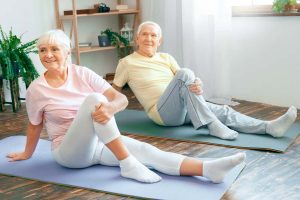Improve Rheumatoid Arthritis Symptoms with Yoga
By John M. de Castro, Ph.D.
“Many people turn to yoga as a way to exercise gently, as well as to reduce tension and improve joint flexibility. Yoga also can help a person with arthritis build muscle strength and improve balance. In addition, yoga offers people with arthritis a form of exercise that is enjoyable enough to do regularly.” – Susan Bernstein
Arthritis is a chronic disease that most commonly affects the joints. Depending on the type of arthritis, symptoms may include pain, stiffness, swelling, redness, and decreased range of motion. It affects an estimated 52.5 million adults in the United States. It is associated with aging as arthritis occurs in only 7% of adults ages 18–44, while 30% adults ages 45–64 are affected, and 50% of adults ages 65 or older. Due to complications associated with rheumatoid arthritis (RA), the lifespan for people with RA may be shortened by 10 years. This is due to a higher incidence of cardiovascular disease in rheumatoid arthritis (RA) patients, with the risk more than double that of non-RA individuals.
Obviously, there is a need to explore alternative treatments for rheumatoid arthritis. One possibility is contemplative practice. A variety of which including yoga practice have been shown to have major mental and physical benefits including a reduction in the inflammatory response and have been shown to improve arthritis. It is reasonable to take time to summarize what has been learned regarding the effectiveness of yoga practice for the treatment of rheumatoid arthritis.
In today’s Research News article “Yoga for Treating Rheumatoid Arthritis: A Systematic Review and Meta-Analysis.” (See summary below or view the full text of the study at: https://www.ncbi.nlm.nih.gov/pmc/articles/PMC7732597/ ) Ye and colleagues review, summarize, and perform a meta-analysis of the published randomized controlled trials of the effectiveness of yoga practice for the treatment of rheumatoid arthritis. They identified 10 published trials that included a total of 840 participants.
They report that the published studies found that yoga in comparison to controls produced a significant reduction in pain that was equivalent to the effects of drugs. Yoga with additional medication was found to improve physical function and reduce disease activity (swollen joints) to a greater extent than medication alone. Finally, yoga in comparison to controls produced a significant increase in grip strength.
The findings of the published research suggest that yoga practice is beneficial for patients with rheumatoid arthritis. It appears to reduce pain and joint swelling and improve physical function and grip strength. No adverse events were reported. Hence, yoga is recommended to patients with rheumatoid arthritis.
So, improve rheumatoid arthritis symptoms with yoga.
“yoga classes will provide the opportunity to strengthen muscles, improve flexibility, increase your awareness of body posture, relax using breathing exercises. These benefits can lead to less arthritis pain, increased joint range-of-motion, and better joint function.” – Ron Miller
CMCS – Center for Mindfulness and Contemplative Studies
This and other Contemplative Studies posts are also available on Google+ https://plus.google.com/106784388191201299496/posts and on Twitter @MindfulResearch
Study Summary
Ye, X., Chen, Z., Shen, Z., Chen, G., & Xu, X. (2020). Yoga for Treating Rheumatoid Arthritis: A Systematic Review and Meta-Analysis. Frontiers in medicine, 7, 586665. https://doi.org/10.3389/fmed.2020.586665
Abstract
Purpose: Rheumatoid arthritis (RA) is a pervasive inflammatory autoimmune disease that seriously impairs human health and requires more effective non-pharmacologic treatment approaches. This study aims to systematically review and evaluate the efficacy of yoga for patients with RA.
Methods: Medline (through PubMed), Cochrane Library, EMBASE (through SCOPUS), and Web of Science database were screened through for articles published until 20 July 2020. Randomized controlled trials (RCTs) of yoga in patients with RA were included. Outcomes measures were pain, physical function, disease activity, inflammatory cytokines, and grip strength. For each outcome, standardized mean differences (SMD) and 95% confidence intervals (CI) were calculated.
Result: Ten trials including 840 patients with RA aged 30–70 years were identified, with 86% female participants. Meta-analysis revealed a statistically significant overall effect in favor of yoga for physical function (HAQ-DI) (5 RCTs; SMD = −0.32, 95% CI −0.58 to −0.05, I2 = 15%, P = 0.02), disease activity (DAS-28) (4 RCTs; SMD = −0.38, 95% CI −0.71 to −0.06, I2 = 41%, P = 0.02) and grip strength (2 RCTs; SMD = 1.30, 95% CI 0.47–2.13, I2 = 63%, P = 0.002). No effects were found for pain, tender joints, swollen joints count or inflammatory cytokines (i.e., CRP, ESR, IL-6, and TNF-α).
Summary: The findings of this meta-analysis indicate that yoga may be beneficial for improving physical function, disease activity, and grip strength in patients with RA. However, the balance of evidence showed that yoga had no significant effect in improving pain, tender joints, swollen joints count, and inflammatory cytokines in patients suffering from RA. Considering methodological limitations, small sample size, and low-quality, we draw a very cautious conclusion in the results of the estimate of the effect. High-quality and large-scale RCTs are urgently needed in the future, and the real result may be substantially different.
https://www.ncbi.nlm.nih.gov/pmc/articles/PMC7732597/
